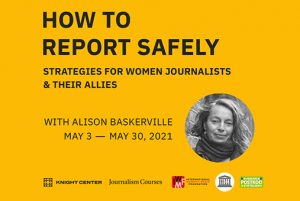Women journalists and their allies now have another toolbox for managing and mitigating risks encountered in the reporting process.
“How to report safely: Strategies for women journalists & their allies” is now available as a self-directed online course that can be taken through JournalismCourses.org, Knight Center’s online learning platform.
 Originally offered as a Massive Open Online Course (MOOC) from May 3 - 30, it attracted 1,235 students from 121 countries.
Originally offered as a Massive Open Online Course (MOOC) from May 3 - 30, it attracted 1,235 students from 121 countries.
"I hope the course gives us a more collective approach to journalist safety and has made those who are less vulnerable to sexual and gender-based violence understand more of the challenges," said instructor Alison Baskerville, lead inclusive safety trainer for the International Women's Media Foundation (IWMF). "I know that many students opened up and shared their personal stories and I wanted to thank those people for their courage to do so."
Upon ending the MOOC, she reflected on the responsibility that cis women and members of the LGBTQ+ often shoulder when it comes to safety.
"I think it’s time to create more space for mixed trainings like these to spread awareness and activate better allyship across our broad and global community of journalists," Baskerville said.
The MOOC and self-directed version are organized by the Knight Center for Journalism in the Americas, in partnership with IWMF and UNESCO, with financial support from the Swedish Postcode Foundation.
Baskerville teaches the course using video classes, readings, exercises, and more. Baskerville’s interviews with health and safety experts, as well as fellow journalists, are also part of course materials.
Students can take the course, which is divided into four modules, at their own pace:
“How To Report Safely is an important resource for women journalists and allies alike. Almost all journalism safety courses cover major threats like how to survive a terrorist attack, treat a bullet wound or what to do in a natural disaster. These are vital topics. However, what is often missed is a more nuanced discussion of the risks that come with our gender identity, and what we can do to mitigate them,” said Nadine Hoffman, IWMF deputy director.
“As women and non-binary journalists, we face layered threats, and it’s critical to address them candidly, as Alison Baskerville did with empathy and deep expertise in this MOOC. While we have much more work to do to create an inclusive journalism safety culture, this is a critical step in the right direction,” said Hoffman.
“I really think [the course] has equipped me with the tools to be better prepared whenever I go out to report on a story,” one course participant said in final evaluations. “I currently work from home, so at times I don't think of the dangers many journalists experience. This information will help whenever I do end up working in the field and I will definitely pass on this information to my colleagues."
“My favorite part was reading relatable articles that listed reasonable responses or ways to mitigate the issue,” another said.
If you took the course as a MOOC and just need more time with the readings, videos or other materials, or if you are completely new to the topic and need education around managing and mitigating your reporting risks, check out the self-directed version on the JournalismCourses.org online learning platform.
While you’re there, check out the more than 35 other courses you can take at your own pace.